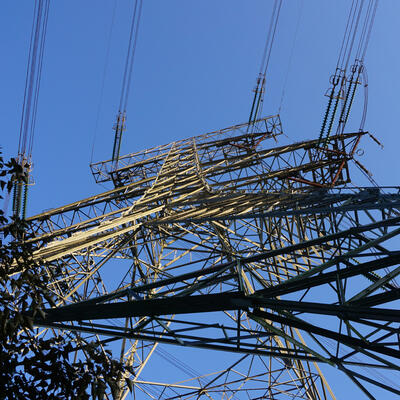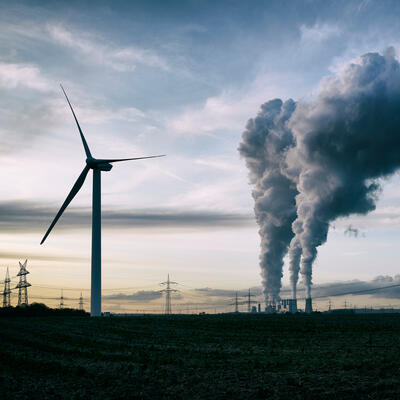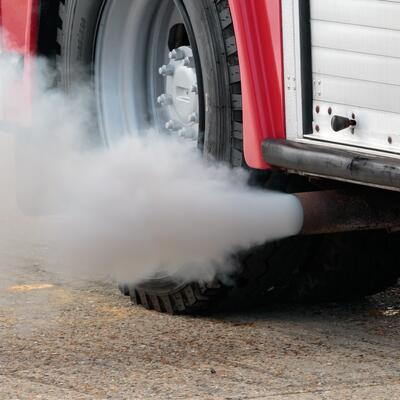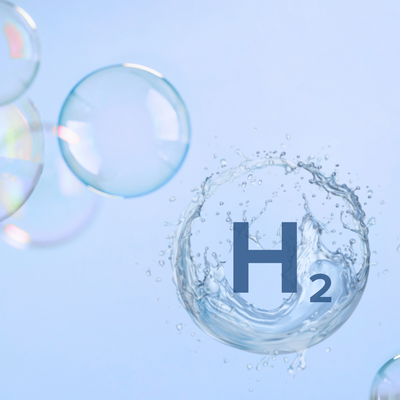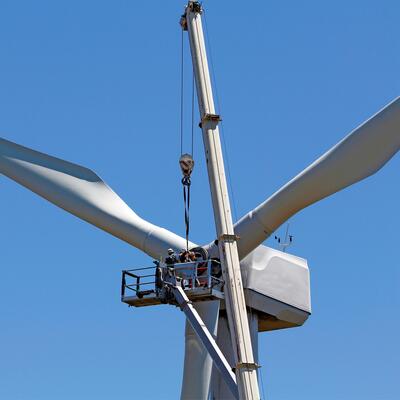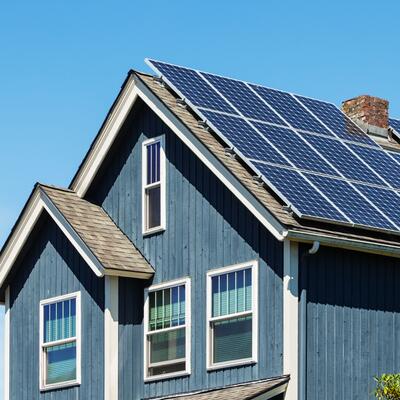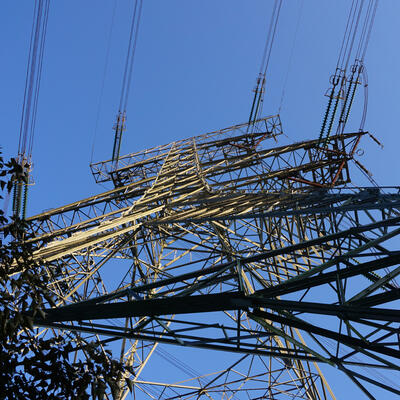
Electrify Everything
Guests

Saul Griffith

Cynthia Williams
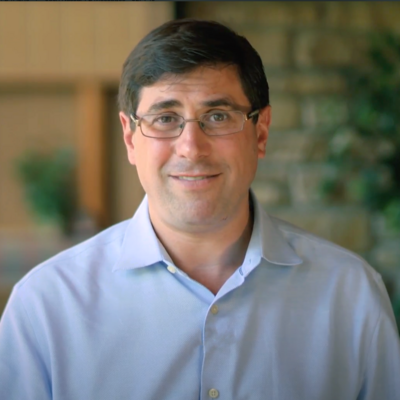
Josh Nassar
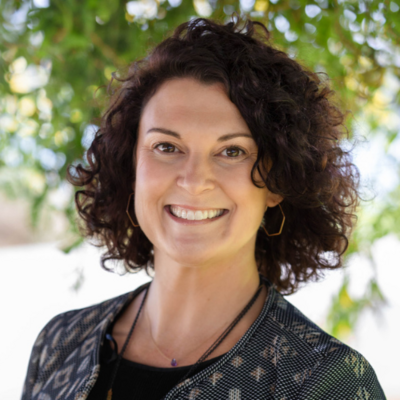
Sara Baldwin
Summary
In the not-to-distant future, your entire home could be electric – from your stove to your water heater to the car you drive. And all of it might be powered by solar panels on your own roof or one nearby – and your car could also put power back into the grid.
This is part of the net zero future envisioned by inventor and entrepreneur Saul Griffith in his new book Electrify: An Optimist’s Playbook for Our Clean Energy Future. Griffith says that when we electrify everything, we’ll only need about half the energy we currently use.
“We generate our electricity thermoelectrically. But a huge amount of that energy is wasted as heat,” he says, pointing out that an electric car, for example, only uses about a third of the energy to go the same distance as a gas car. Griffith says electrifying all our machines and homes will require three to four times more electricity than we currently generate, which means a massive ramp-up of more wind and solar on rooftops, in community arrays and out in the countryside.
“There’ll be some geothermal; there’ll be some biofuels for some applications; there'll be some hydroelectricity. But wind and solar are now proven to be the cheapest generators of electricity in the world.” Griffith also sees a role for some nuclear power, provided new sources can come online in the next 20 years.
That transition will also require reorienting our electric grid to be “neutral,” and allow for energy to go both ways, as opposed to the current unidirectional model that advantages traditional electric utilities, he says. And it won’t happen overnight. But if we begin replacing our cars, water heaters, furnaces (as they reach the end of their useful lives) with electric models, this shift will happen over the next couple decades and begin to provide “thousands of dollars in savings in every household every year.”
The transportation sector is the biggest source of US greenhouse gas emissions. President Biden wants half the cars sold in the US to be electric by 2030. And automakers are increasingly putting money and marketing muscle behind EVs.
Ford's F-150 truck has been the best-selling vehicle for decades. Next year the company will release an electric version, the F-150 Lightning, and the company has already received more than 120,000 pre-orders.
“I think the response to the offering from Ford is indicative of what consumers are increasingly asking for which is a high-performance vehicle that gets the job done and can do a number of things both from a family standpoint as well as a workforce standpoint, but also that is not compromising to our environment, our public health and the climate,” says Sara Baldwin, director of electrification policy at Energy Innovation.
Ford recently announced an $11 billion investment in two new factories in the southeast to make batteries and employ a combined 11,000 workers. Cynthia Williams, global director of sustainability at Ford, says the company is also working on electrifying its heavy-duty models. “40% of our volume we plan to be fully electric by 2030 timeframe.”
Josh Nassar is Legislative Director at United Auto Workers of America. He says it’s important that new EV production doesn’t leave behind communities built around jobs in the internal combustion engine. “So, being very deliberate in that in our policymaking is very, very, very important for the success of the entire effort,” he says. “And we need to be successful, not just for the environment but also for having a leading U.S. auto industry, because the rest of the world is moving forward.”
Note: Ford Motor Co. is among Climate One’s sponsors. This program was underwritten in part by ClimateWorks Foundation.
Related Links:
Electrify: An Optimist’s Playbook for Our Clean Energy Future
Full Transcript
Greg Dalton: This is Climate One. I’m Greg Dalton. Fully electrifying our homes and cars could cut the amount of total energy we need by half:
Saul Griffith: We generate our electricity thermoelectrically. But a huge amount of that energy is wasted as heat.
Greg Dalton: President Biden wants half of the cars sold in the US to be electric by 2030. And automakers are increasingly putting money and marketing muscle behind EVs.
Sara Baldwin: We are seeing opportunities in more states with electrification, and the expansion of this market is huge and we’ve really only begun to scratch the surface.
Greg Dalton: And as we make this shift, equity is essential.
Saul Griffith: It is simply stated, and obviously true that you don't fix climate change if only 50% of people can afford the solutions.
Greg Dalton: Electrifying Everything. Up next on Climate One.
Greg Dalton: This is Climate One, I’m Greg Dalton.
Greg Dalton: In the not-to-distant future, your entire home could be electric--from your stove to your water heater to the car you drive. And all of it might be powered by solar panels on your own roof or one nearby -- which would also put power back into the grid. This is part of the net zero future envisioned by inventor and entrepreneur Saul Griffith, in his new book Electrify: An Optimist’s Playbook for Our Clean Energy Future. Griffith says that when we electrify everything, we’ll only need about half the energy we currently use.
Saul Griffith: Fundamentally electric machines don't generate the waste heat that internal combustion engines do. An electric car uses about one third of the energy to go the same distance as a gasoline car provided that you provide the electricity from a clean source like wind or solar or hydroelectricity. When you use a heat pump to heat a room it uses about one third the energy that a natural gas heater would use to heat the same room. And then what’s underappreciated in American energy economy today and if I can all of the countries of the world is that we generate our electricity thermoelectrically. What that means is we heat water to make steam to spin a turbine to turn a generator to make electricity. But a huge amount of that energy is wasted as heat. Sometimes half in natural gas, sometimes two thirds of the energy is wasted as heat if you’re doing it with coal. So, if we electrify all of the demand-side machines that means the things that you and I recognize because they are in our garage or they’re in our kitchen or they’re in our basement. And then we provide them all with electricity that’s produced with sunshine and wind. We actually probably only need 40%, definitely less than half of the energy we think we need today.
Greg Dalton: And you say that electrifying everything will require 3 to 4 times as much of electricity as we currently generate. So, we’re gonna need less total energy but replacing oil with electricity means a lot more electricity. So, how will we accomplish that in short order and who's gonna pay for it?
Saul Griffith: So, America uses 3 1/2 TW of what they call primary energy. Primary energy is defined as tons of coal tons or barrels of oil. But only about a half a terawatt or 500 GW is electricity delivered to the end-user today. So, if we electrify everything, we actually need to triple that amount of electricity to about 1 1/2 TW meaning a lot of that but 3 1/2 goes away. That will mean enormous amounts of wind and solar generation as much as 20 or 25% can probably be generated on our roof tops of our houses and our commercial buildings. We can probably do another 10% in our communities in what’s called community solar. But then we’ll still need on top of that, some utility scale generation that’ll be out in the countryside. And we shouldn't rule out nuclear, America's actually had a very good safety history with nuclear. Whether the nuclear can arrive in time is the real question because we sort of need to do this transition in 20 years and in the last 20 years, we only commissioned one new nuclear plant and we retired more than we commissioned.
Greg Dalton: Yeah, a couple of them went bankrupt and they didn’t work out well those new ones. They were over budget they were fiascos.
Saul Griffith: So, actually I think if you’re a betting person the majority is gonna be wind and solar. There’ll be some geothermal; there’ll be some biofuels for some applications there’ll be some hydroelectricity. But wind and solar are now proven to be the cheapest generators of electricity in the world.
Greg Dalton: There’s still this kind of perception that green cost more. And Bill Gates has been out there, talking about the green premium. So, if new wind and solar utility scale are the cheapest energy on the planet, is that gonna pass through to customers?
Saul Griffith: So, I have the benefit that Bill doesn't - being Australian citizen so I get to have a broader picture of the goings on in the world. And there is a green premium today for some things, but that green premium is being breached. So, today if you went to buy an electric car so let’s just take a middle-of-the-road like a Hyundai Kona electric is about 10,000 or $15,000 more than a Hyundai Kona gasoline model. But Bloomberg new energy finance is predicting that by 2025 or so, electric vehicle will be cheaper than the internal combustion engine vehicle.
Greg Dalton: To buy and it’s already cheaper to operate.
Saul Griffith: It’s already much cheaper to operate. An electric car running off solar on your roof is three or four cents a mile and a gasoline car is 10 to 20 cents a mile depending on what it is. So, we’ll bridge that gap shortly on the vehicles. In Australia, there's been something called this trend rooftop solar miracle. So, we got pretty smart about regulation and certification and training in Australia and eliminated what’s called the soft cost of installing solar. So, the solar modules themselves cost about $.30 per watt. In Australia it would cost you about a dollar per watt to install it on a roof after all the labor and the racking and the inverters and the connecting it up. In America it costs about three dollars per watt because we have extra regulatory burden permitting burdens inspections. At the Australian price rooftop solar electricity in Australia after you've gone to the bank and finance it is five or six cents per kilowatt hour of electricity delivered to your house.o put that in perspective, the average in the US is 13.8 cents. In California I know I’m paying about $.22 and I'm sure you're paying about $.20 a kilowatt hour. So, it is fair to say delivered to the customer the cheapest electricity in the world is in Australia right now the rooftop solar. And that could be true here too and that's something that we could make possible with a regulatory pin. The other amazing thing that has happened in terms of this green premium, yes, it does cost you more for the electric induction stovetop and it does cost you more for the electric heat pump water heater and the electric heat pump furnace. But all of them are now at parity over their lifetime because their performance is so good and they are cheaper to operate. To return to your original question. I don't think it’s quite the question of who's going to pay for it, which plays to the narrative that I think is all too common that this is going to cost us all money. If we do this right, if you could create a country that had the rooftop solar policy of Australia, the electric vehicle policy of Norway or California. And so, the heat pump and building heating systems and policies of Japan or South Korea. You do have the right set of things to start saving consumers thousands of dollars a year.
Greg Dalton: It sounds like an interesting place to live. You write that there can be no not in my backyard with solar and wind energy. But in practical terms, we all know that NIMBYism is alive and well. So how do you propose we change people's minds about solar and wind, even if it’s cheap, across our cities and farms?
Saul Griffith: I don't think we’ll change everyone's minds in the timeframe required. I'm not mad about that. There are enough spaces even for the people who will prevent some of these installations from going in to still meet all of the demand. I think what we need to do is change as many of those minds as possible that this is the future and one of the things is to outline how much space and how much ugliness some of the existing energy infrastructure is. We have hundreds of thousands actually millions of miles of natural gas pipeline in the US that leaks; we have millions of miles of oil pipelines that create other problems. And in fact the footprint of the solar and the wind we need is not substantially more than the footprint that we have for this existing fossil fuel infrastructure. If you think about the setbacks that are required for those pipelines. The setbacks that are required for the rail that is dedicated to taking coal from where it's mined to where it burned. And so, I think there's a lot to win here. We won’t win everyone over but even, I think we will find enough space to put all of the renewables that we need.
Greg Dalton: I often hear talking about EVs, well can the grid handle it. So, we know the grid is old in the United States in a lot of places it's under invested and perhaps there are some potentially some help on the way if this infrastructure bill gets passed. Can the grid handle a sudden influx of convection cooktops, electric vehicles and so forth?
Saul Griffith: The answer is absolutely not today. But I think it's worth reminding us ourselves a few things. We have two or three decades to achieve this project to hit the climate targets we need to hit. So, two or three decades is not exactly overnight. I was reminded yesterday that the US grid doubled the amount of electricity that it delivered between 1950 and 1960 and then it doubled that again between 1960 and 1970. So, we did 4X the electricity in 20 years, which is very analogous to what we have to do today. And as far as I can remember we have a lot more technology with which to do that type of project today than we did in 1950. So, I think it's not infeasible that we can deliver all of that more load. We also need to change the rules of the grid because a lot of the energy flows now are gonna be bidirectional. Historically electricity just went one way into your house. Now we need electricity to go both ways. So occasionally, your car is cooking my breakfast, and sometimes my home battery is heating your living room in the evening. So, making, you know, getting those rules right making all of these devices that will have small computers talk to each other and coordinate that in a very analogous way to the way that the Internet coordinates all of our communications transactions that needs to happen. I think really the answer to the question is if you choose to not want to solve the problem that is climate change and go through the energy transition you can always find reasons why this is going to be hard or difficult.
Greg Dalton: That precedent of 4X from ’50 to ’70 is remarkable. A lot of what was happening there was rural electrification, bringing electricity to people who didn't have it yet and that was kind of an equity rural America farms in America. So, how do we ensure equity in this transition to make sure the people who are most vulnerable and can’t afford some of these things are not left behind?
Saul Griffith: To be perfectly honest I think this is the most important question in the climate debate period. It is simply stated, and obviously true that you don't fix climate change if only 50% of people can afford the solutions. It's also fairly obvious and true once you stated that like roughly half of people pay net tax and roughly half of people receive some benefit. That's the idea behind the tax system. So, how do you finance this and how do you enable the 50% of lowest income households to come along for the ride is enormously important. And I think we need to employ every possible mechanism to do that and it potentially is the greatest equalizing political movement that will ever happen in solving climate change because we have to be by necessity, we have to bring everyone along. We’ll do some of that with creative financing we’ll do some of that with grants and rebates to do something with subsidies and we need to do all of the above. Otherwise, the problem doesn't get solved. And I think we should be honestly preferentially prioritizing some of those communities in the pilots that we need to do to learn how to do this so that they become advocates for the solution and the political wedge isn't driven there.
Greg Dalton: You’re listening to a Climate One conversation about electrifying everything. Our podcasts typically contain extra content beyond what’s heard on the radio. If you missed a previous episode, or want to hear more of Climate One’s empowering conversations, subscribe to our podcast wherever you get your pods. Coming up, redesigning the grid to better accommodate renewable and battery energy:
Saul Griffith: The sun is only out for roughly half the day and then it's down to the other half and the wind doesn't always blow. So, this is the unreliability of wind and solar. The other way I’m looking at is actually the sun is incredibly reliable and it's come up every day for the last 3 billion years and will continue to do so. And we’ve just got to learn to bank on that reliability put that energy into batteries and then redistribute it in a grid that has new rules that allows the energy to go both ways. (:28)
Greg Dalton: That’s up next, when Climate One continues.
Greg Dalton: This is Climate One. I’m Greg Dalton. Let’s get back to my conversation with Saul Griffith, author of Electrify: An Optimist’s Playbook for Our Clean Energy Future. I asked him to explain the concept of grid neutrality, which he says is critical to the all electric future.
Saul Griffith: The grand bargain in the mid-20th century was to give a virtual monopoly to utility operators in exchange for them guaranteeing very high reliability of service of electricity to the users and making sure that they did not overcharge people who were older or infirm or something like this. But because of that the utilities set the rules and they set the rules for energy generating systems that look like the ones they are in for distribution grid that looks like the one that they operate that they use today. Without doubt as we transition the largest battery that will exist in the United States will be the battery of our 250 million vehicles. And those batteries will move around every day that's fundamentally different to the 20th century infrastructure. The second-biggest battery that will exist is the battery inside the thermal systems of all of our homes. The hot water heaters and the space heaters. And the batteries that are on the side of our house to help us backup. If everyone can stay also fairly obviously true that the sun is only out for roughly half the day and then it's down to the other half and the wind doesn't always blow. So, this is the unreliability of wind and solar. The other way I’m looking at is actually the sun is incredibly reliable and it's come up every day for the last 3 billion years and will continue to do so. And we’ve just got to learn to bank on that reliability put that energy into batteries and then redistribute it in a grid that has new rules that allows the energy to go both ways. And I think if we want the benefits of this transition to go to households which I think should be our priority. We need new rules for the grid that don't advantage the traditional utility model. We want households to be treated the same as utility scale generators and we want vehicles and the batteries in our households to be equally treated in terms of storage. Because I think we really need to make sure that the economic benefit is passed on through to the voter to the consumer however you want to look at them because at the end of the day unless they are realizing the benefits of this transition there is gonna be resistance that’s gonna slow us down.
Greg Dalton: One of the most dramatic stories recently has been the move to electrify buildings and keep natural gas out of new buildings. In some cases, existing buildings. That took off quite quickly. The natural gas industry came back, the methane industry, pretty quickly and forcefully opposing local governments trying to move toward all new electric construction, those sorts of things. The pipefitters are in there also trying to preserve that they’ve successfully blocked such moves in several places. If we want to electrify everything, what can be done to overcome the resistance of the incumbent methane fossil gas industry and the unions that are part of it?
Saul Griffith: I think the way people conceptualize this transition is that it’s all gonna happen and tomorrow we’re just gonna turn off all of the fossil fuels and then turn on everything electric, and everyone's job goes away tomorrow. That’s just not physically possible. We have 90 million homes with natural gas connections that have 60 odd million in natural gas furnaces and etc. etc. all of those machines last 10 to 20 years and some of them were only purchased last year. To hit our climate goals, you roughly just need to make sure that the next time one of those machines is retired that it is replaced with an electric clean machine. In a workforce training sense that means you’re not gonna lose your job as a pipefitter today you just don't train your daughter to become one for the next generation because there will be 20 years more of transitioning out those machines. And the good news is that there will be more labor more than likely building the replacements that will be electric heat pumps and these are things similar skills in those jobs. We just need to make sure the way to do is as you transition out at the end of your career and your daughter is trained as a heat pump technician or an HVAC technician or a wind power technician or a solar farm installer that's the cadence. So, it’s now to be expressed in a single generation this transition. And I think it's critical that we get these unions and these organizations on side because quite frankly, we need all of those skills. There's an enormous shortage in electricians and enormous shortage in HVAC technicians and enormous shortage in the people who will actually go out and engage in the transition of all of this machinery that needs to be electrified.
Greg Dalton: We’re talking here about electrifying everything and electric cars are definitely a lot better than gasoline cars in many ways. They’re more fun to drive more efficient as you described, but some people would say that replacing gas cars with electric cars still is too many cars still car dependent. What do you say to reworking having more transit centric more transit-oriented housing development, those sorts of things that simply switching gas cars for electric cars still leaves us with a problematic car centric culture?
Saul Griffith: I think that’s absolutely true. So, there's a little piece of me that’s extremely sympathetic to that argument because I was actually arrested with 5000 of my closest buddies riding our bicycles across the Sydney Harbour Bridge on the evening before Australia didn't sign the first Kyoto protocol. And I was an enormous advocate for, you know, everyone should walk everyone should ride bikes, you know, there should be no cars we should all do transit. And while there’s still a piece of me that is all of those, I think having been married for 15 years to a wonderful woman who I love very dearly who won’t ride her bike everywhere that I want to ride. I now realize that even if a marital bond is not enough to make someone an advocate for giving up their car, you're not gonna convince the whole population. And I think you can now state technically the truism is you could solve climate change with a substitution model give us all the same size cars same size homes all of these things just do it with electric generate that electricity and we could achieve that. I think that's an easy sell and I have largely just written a book that tells you that story, but the last chapter does try to warn you that we can solve climate change, but still have an ocean plastics problem. We can solve climate change but still spend 50 minutes of our days locked in gridlock traffic because there's just so many cars in overcrowded cities. So, I do hope that we do more mass transit, but I don’t think you can go out with a narrative that tells everyone we’ll solve climate change by forcing you to give up your car. So, I stop trying to push that.
Greg Dalton: They’re coming for your cars and your burgers is playing right into the people who want to slow this down. Saul Griffith is an inventor, entrepreneur and author of Electrify: An Optimist Playbook for Our Clean Energy Future. You write that billionaires can escape to Mars, but the rest of us have to stay and fight. What do you think of billionaires, often white men who made their fortunes in tech and finance leading the systems change required to stabilize the climate? Do you trust their motivations and do you think that we ought to look for those kinds of heroes to lead the systems change that we’re talking about?
Saul Griffith: I know more than my fair share of billionaires and I actually think their motivations are good. The ones that I interact with they’re generally interested in climate and they’re generally interested in climate solutions. And their motivation is similar to my motivation and it’s like we would like to maintain the health of the earth and its ecosystems for our children. I do observe, however, that billionaires typically have been removed from the realities of life for a few decades. And it makes their perspective on what solutions look like unrealistic. And I think unfortunately the way the world’s political systems and economic systems have developed billionaires have an outsized influence on our politics and how these things happen. So, I think there's no way to solve climate change without engaging a lot of them. But I think the most critical thing for billionaires to learn is empathy for the average human condition. What I’d like them to do is develop empathy. So, you know, drive through a low-income suburb in Ohio and imagine the climate change electrification journey of a single mother on a low income. How are we going to bring those people along on this grand journey to address climate change? And I think you need that empathy to understand where the real barriers are. Most of the billionaires I know they tend towards libertarian; they don't believe that the government has any role here. When you go to hand your hat around in Silicon Valley to ask if they would sign up to support the bills trying to go through Congress right now on climate. They say well there's a whole bunch of stuff in there that I don't like and I don't believe government should have such a role, and I think that's just naïve. The energy system is one of the most regulated pieces of modern life and a huge portion of the cost is regulatory. And if we don't have regulatory reform, we’re not gonna solve climate change, and we need this sort of libertarian attitude to give way to empathy and engagement. Empathy for real people's real experience and engagement with the political process in a way that makes the future that we need to make possible possible. None of those activities look like going to space.
Greg Dalton: Right. So, not so much from the elites. The idea that the Silicon Valley will solve this or the political and economic elites will solve this.
Saul Griffith: I'm over that narrative. Nearly everything that Silicon Valley commercializes actually began with the sae bureaucrat running funding for the same things, including solar energy, including batteries, including wind power, including pathways to make steel without carbon dioxide. All for these things actually came from the taxpayers’ dollars funding well motivated bureaucrats to run smart programs and research programs through national labs through universities through independent companies to develop these technologies.
Greg Dalton: Yeah, well, the Internet came from the defense advanced research projects agency and semiconductors came from aerospace. So, yeah, that's a --
Saul Griffith: Exactly.
Greg Dalton: You’ve worked on research projects for many federal agencies, including NASA and DARPA. What have you learned about how quickly they can make big changes and do we need to go back to those you know thankless bureaucrats you just mentioned, and empower them and celebrate them because they are key to this?
Saul Griffith: I would love for them all to be celebrated. Nearly every technology that we need is already at the table and fixing climate is testimony to that success. That’s not to say that we shouldn’t still swing for the fences even more. Certainly, an ambitious program manager at ARPA-E that could help bring a new fusion technology to market within the decade would have an enormous impact on climate. There’s still a whole lot of good research problems where substantial breakthroughs would make solving climate a hell of a lot easier.
Greg Dalton: And you repeatedly point out that there will be a better quality of life, not major sacrifices, right, but then don’t we need people to be engaged in addressing the climate crisis in order for it to be sufficient public pressure to make this transformation happen?
Saul Griffith: Yes. I think you do need people to fear what we have to lose. There are two things that people feel that we have to lose. Some people fear that we have to lose the natural environment, species biodiversity, the health of the ecosystems that enable our species to thrive. Some people fear the loss of their barbecue or their monster truck. It is possible now to give people their barbecues and their monster trucks and do it electrically and take that fear of loss away but still be motivated by the fears around what we have to lose in terms of the environment. But I actually think the majority of people are motivated by the what we have to win narrative. What do we have to win? We have far healthier children. It is extremely well established and well understood that burning natural gas inside your home, whether it's in the kitchen or in your furnace has a terrible impact on the respiratory health of the people in that and the pets in that house. Tthat problem gets solved by virtue of electricalization and addressing climate change. The health of their communities and the smog and acid is caused by all of the oil we’re burning in our cars is another thing that will lead to greater respiratory health it’ll have huge health benefits beyond that as well and our skies will become clear and the air around us will become cleaner the waterways will become cleaner. On top of that we can now see that energy is very likely to actually get cheaper, not more expensive, which is counterintuitive because we've had three decades of very successful propaganda campaigns telling you, that this is gonna be too expensive. This is going to be too hard. But it's not, wind and solar really are just so cheap now and batteries are about to be so cheap and electric vehicles are about to be so cheap that we’ll see thousands of dollars in savings in every household for every year.
Greg Dalton: Saul Griffith is an inventor, entrepreneur and author of Electrify: An Optimist Playbook for Our Clean Energy Future. Thanks for your insights, Saul and your optimism on electrifying everything around us.
Saul Griffith: Thank you very much.
Greg Dalton: As local governments across the country pass regulations that favor clean energy, some oil and gas companies are going to big and sometimes veiled lengths to make sure their industry isn’t shut-out. One tactic is called astroturfing--where community support for the industry appears grass-roots, but is actually organized by companies to promote themselves. Miranda Green, a reporter with Floodlight, reports on one such case she uncovered at the Ports of Los Angeles and Long Beach, in an investigation with the Los Angeles Times and The Guardian.
Miranda Green: When Sholeh Bousheri testified in front of the Long Beach Board of Harbor Commissioners, she said that the dirty diesel trucks that drove back and forth in her neighborhood shouldn’t be allowed one year longer.
Sholeh Bousheri: “My Name is Sholeh Bousheri and I’m a resident. The people’s health is at risk and waiting five years to make incentives for the trucks to be changed is a long time.”
Miranda Green: It was 2017, and Long Beach officials were gathering input on their new Clean Air Action Plan. The choice was whether to transition the diesel powered trucks that transported shipments from the LA and Long Beach ports to electric trucks or a shorter term change to natural gas. But there was one thing those officials didn’t know at the time: some locals, including Bousheri, had been recruited and paid to testify in favor of the gas option by the gas industry. She thought she was working at an environmental fellowship.
Sholeh Bousheri: “6 months with my bachelors, I could not find a job. She hired me and told me it was an intern position and it’s temporary, that we are going to go and we’re gonna fight for the clean air action plan. And then i find out that it was the gas company”
Miranda Green: A company called Method Campaign Services paid Bousheri $20 an hour to attend trainings and speak at city council meetings. Method was paid at least $10,000 by Clean Energy Fuels, a California gas company with high stakes in the energy transition. Bousheri was one of at least 10 residents hired to speak in favor of the gas-powered trucks. She says she had no idea the internship was linked to the fossil fuel industry. But it turns out her situation isn’t unique.
Adrian Martinez: “It’s very common. You know I've been doing this work in California since 2003 and you know you kind of see it every year, but 4 or 5 years back I saw a big uptick in this strategy and I think there was a growing recognition that the fossil fuel industry just didn’t have the support that it used to. And I think what we’ve seen is a more aggressive effort to resort to these tactics of creating fake movements that want to protect their interests.
Miranda Green: That’s Adrian Martinez, an attorney with the nonprofit law firm Earthjustice, who worked closely with community groups who wanted zero-emission electric trucks at the ports. He said while it may not have been obvious to the local officials at the time, it was clear there was a pretty aggressive campaign to get folks out to testify. Similar tactics have been used by industries across the country. In New Orleans, a public relations firm working for Entergy Corp. paid actors to urge officials at meetings to approve a gas-fired power plant. The American Gas Association paid Instagram influencers to post about how they love cooking on gas stoves.
Adrian Martinez: In many instances like the natural gas industry, they had a pretty positive image a decade ago or more in the region and as people have come to understand more about the harms of you know natural gas and other fossil fuels, I think people are pushing back and i think these astroturf efforts are to kind of counter this pressure cooker we’re in, where people want change and this industry doesn’t want to change”
Miranda Green: And it’s effective. In several places, local government efforts to ban gas hookups in new construction, for example, have been blocked from passing. The industry says they’re making sure their technology is not overlooked. In the case of the LA ports, the conversation was also about cost. Matt Schrap is chief executive officer for the Harbor Trucking Association.
Matt Schrap: We’re a can do kind of industry and electric trucks are pretty cool, I’ve ridden in them, I’ve crawled around on them, the challenge is the truck technology is sort of the lighter lift, so for the trucking industry our main concern is where are we going to charge it, when are we going to charge it, and how much is that energy going to cost?
Miranda Green: According to Schrap, the trucking industry takes a neutral stance when it comes to how the motor is powered, as long as it’s cost effective. But he said he could see why the gas industry paid employees to testify for a technology he agrees is being overlooked.
Matt Schrap: I dont think it’s a new technique and if they’re giving someone $20 to go buy lunch for themselves, is one thing, as opposed to something that might be considered more nefarious. I don't think anybody is innocent in every turn of this discussion, because there are other interests who are pushing just as hard on the electric side of things.
Miranda Green: But port residents Busheri says as someone who cares about the environment, she still feels duped.
Sholeh Busheri: It didn’t make me feel comfortable. I was like, wait what’s going on is this good. Is this something I want to support with you? Is it true, is it honorable, are the activities that they are doing ok? I was more along the lines of, what have I gotten myself into here. Is this right? I took a hold, an ethical stand back when it happened.
Miranda Green: She says knowing what she does now, she would have given more thought to taking the job. For Climate One, I’m Miranda Green in Los Angeles,
Greg Dalton: You're listening to a conversation about electrifying everything. This is Climate One. Coming up, how auto companies are responding to what consumers want from their electric vehicles:
Sara Baldwin: A high-performance vehicle that gets the job done but also that is not compromising to our environment, our public health and the climate.
Greg Dalton: That’s up next, when Climate One continues.
Greg Dalton: This is Climate One. I’m Greg Dalton. The transportation sector is the biggest source of US greenhouse gas emissions. I invited three guests to discuss the current state of the electric car - and truck - market and what the future might hold. Sara Baldwin is Director of Electrification Policy at Energy Innovation. Cynthia Williams is Global Director of Sustainability at Ford Motor Company. Josh Nassar is Legislative Director at United Auto Workers of America. For full disclosure, Ford Motor Company is a funder of Climate One. Ford's F-150 truck has been the best-selling vehicle for decades. Next year the company will release an electric version, the F-150 Lightning, and the company has already received more than 120,000 pre-orders. I asked Sara Baldwin how big a deal the F-150 Lightning is in the move away from fossil fuels.
Sara Baldwin: I think it's huge and I think the response to the offering from Ford is indicative of what consumers are increasingly asking for which is, you know, a high-performance vehicle that gets the job done and can do a number of things both from a family standpoint as well as a workforce standpoint but also that is not compromising to our environment, our public health and the climate. Also, the fact that it provides battery backup and an emergency response performance component is huge. I mean resilience is front and center for a lot of people right now. Everywhere we look we got climate disasters and natural disasters coming at us. So, I think kudos Ford and to all the innovators out there who came to the table with this incredible offering.
Greg Dalton: Yeah, the electric F-150 kind of a big cultural moment in this country. Cynthia Williams, Ford sells about 900,000 F-150 trucks a year, bringing more than $40 billion in revenues. What are the company's expectations for making and selling F-150 Lightnings and will Ford put marketing muscle behind it?
Cynthia Williams: Oh, absolutely. We think we have a huge opportunity here with this customer and with the orders that we’re seeing about 80% of the orders are new customers to Ford. And so, we’re hoping to you know, just build on what we’re doing in terms of bringing vehicles that customers love to our portfolio. And you know our approach is to highlight or to electrify our iconic products and these are vehicles that customers already understand and love. And so, our goal is to bring the capability of what they you know the know-how of the vehicle by making sure it’s high-performing high-quality, capable of doing the job is the main thing for the consumer.
Greg Dalton: Right. Ford was late to the electrification game compared to some other companies but now putting its iconic Mustang and F-150 electrifying them rather than some kind of niche models. But, Cynthia, SUVs and trucks have fat profit margins but the electric F-150 will be loaded with expensive batteries. How long will it take Ford to make money on the electric F-150?
Cynthia Williams: Out the gate we’re making money on the electric F-150. And again, the goal with the large volume that we have it with you know America's best-selling truck for over 40 years. We’re making sure that we can commonize as many parts as possible and bringing a vehicle affordable vehicle to customers.
Greg Dalton: Josh Nassar, Ford CEO Jim Farley admitted recently that there is some tension among workers about the company's electrification moves. What concerns does the United Auto Workers have about the move away from internal combustion engines and what that means for jobs?
Josh Nassar: Well, I mean with this shift that’s just gonna take place, you know, over on a certain amount of time but it’s taking place. You know, that means that there’s new battery production. It means that there’s, you know, changes in the supply chain. And there’s a concern that those jobs, you know, will not be of the same standard of the jobs that they’re accustomed to. Good middle-class jobs that you can really build a future on. So, there's a lot of uncertainty there and you know the reality is there's a lot of a nonunion auto companies out there who take a pretty aggressive stance around, you know, when workers are trying to get together and form a union.
Greg Dalton: Ford recently announced an $11 billion investment in two new factories in the southeast to make batteries and employ a combined 11,000 workers. Cynthia, will those new battery jobs be unionized?
Cynthia Williams: We plan to have the unions to localize there. We will give the employees the opportunity to join the unions and we respect and we’ll leave that opportunity and that commitment to the employees for them joining. But we think new jobs are coming, we’re partners with the UAW. My dad was a UAW worker for 30 years so I have huge respect for the UAW.
Greg Dalton: UAW says it supports the move. But Josh the southeast is not known for being union friendly. What's your take on this big move to the southeast?
Josh Nassar: You know, we have members throughout the country from all regions. And you know if workers have a fair chance you know to join a union, you know, we think that that's provided then it’ll be a great outcome and no reason to think it won’t. And we have master contracts so in final assembly the wages is set in the national agreement are consistent throughout.
Greg Dalton: Sara, an article in The Atlantic sees a bargain in Ford moving production into two right-to-work states that bar factories from requiring workers to join a union to work there. The article says, quote “climate concerned Democrats get to see EV production expand in the US while climate wary Republicans get to add jobs in their home states and unions get shafted." So, what do you think about this move in terms of the politics of moving away from fossil fuels and electrifying things in this country?
Sara Baldwin: I'll say first and foremost, I am not a labor expert nor do I opine on the politics of unionization as a matter of just practice and I’m an electrification policy person, but that has its reach. I think the bigger picture here is that we are seeing opportunities in more states with electrification and the extension of this market is huge and we’ve really only begun to scratch the surface. So, my take away would be more jobs in more states, and you know the opportunities for not just the cars themselves but the supply chain and the expanded infrastructure for software and hardware alike. I think we’re gonna see, you know, I'm hoping to see with more policy focus, especially that there will be a concurrent emphasis on the jobs, good paying jobs as well as this EV transformation. I don't think that they have to be in conflict. I think we’re undergoing a pretty substantial transformation in our workforce writ large for a lot of reasons. And globalization as well as global competitiveness should be a primary focus so bringing more jobs back to the US, getting more domestic manufacturing and ensuring that the US is gonna play in this market I think is really where we're trying to focus.
Greg Dalton: Josh Nassar, is it possible that someone builds internal combustion engines and they can move to electric cars? Are those the same people the same skills? Because electric cars have a lot fewer parts?
Josh Nassar: So, first of all, our members I mean they learn new technologies and go through retraining consistently. So, as far as a workforce being able to do the work, that's not a concern. What we need to make sure is that we’re a leader in the world on EV production and that we’re actually in the position where we’re exporting EVs. And, you know, that’s where there are some real, you know, opportunity. So, the question is, as a country are we gonna back this transition or not. I mean you look at countries like China I mean they're leading it didn’t happen by accident. There was government policy which you know led to that growth. And frankly we’ve been falling short here so that’s why we’re optimistic that we’re turning a corner but you know we need to make this happen.
Greg Dalton: Sara, auto companies in the US and European are investing tens of billions of dollars to move from internal combustion engines to electrification. These are announcements and intentions and directions but it wasn’t that long ago the auto industry pivoted in another direction after the 2016 election. So, why should we believe the auto companies today talking up EVs that they won't turn on a dime if a Republican president is elected in 2024?
Sara Baldwin: Well, I won't speak on behalf of any of the companies, particularly since you have one right here and can answer that better than I. What I would say is kind of my reflection on the market is that prices for batteries have declined faster than we’ve anticipated. In fact, every projection is exceeded every year. And so, we’ve seen between 2010 and 2020 about an 89% decline in battery prices and another 20 to 30% decline anticipated in the next five years. We can expect that that will only continue. Consumers again are demanding more models, more options and that consumer demand I think is only going to increase as more people want to be a part of the climate solution. Third, I think the recognition that Republican or Democrat president or Congress doesn't matter as much because this market is moving and we are going to see transformation occurs sort of from the ground up. However, with that said, strong policies can make a huge difference in securing this marketing giving more stability to automakers, autoworkers, consumers alike. Whether it's stronger regulations and more rigorous standards as well as incentive programs that we’re seeing proposed through both the infrastructure bill as well as the Build Back Better Act. There are a lot of opportunities for us to seize this moment and really drive forward with a concurrent solution that meets all of our needs.
Greg Dalton: Josh Nassar.
Josh Nassar: Totally agree with that. And just I think it's really important that when we’re looking at where the new production goes that we make sure that the communities which you know are impacted by you know by the reduction in nice vehicles aren’t left behind. And what I think what’s really critical is that we make those investments in a targeted way. People need proof that this is going to result in good jobs and people need that you know not just a promise of new jobs will appear in some time. So, being very deliberate in that in our policymaking is very, very, very important for the success of the entire effort. And we need to suffer to be successful, not just for the environment but also for having a leading US auto industry because the rest of the world is moving forward.
Greg Dalton: Sara Baldwin.
Sara Baldwin: One of the things that I'm really heartened by in the particularly the Build Back Better Act in some of the provisions granted this is being cobbled together from multiple committees it’s still a work in progress nothing is set in stone. But if you look at the proposed language coming out of ways and means there are a number of provisions that speak to this need for assuring jobs will be there, including if you're going to get a tax credit from domestic manufacturing of vehicles and EVs you have to meet prevailing wage requirements and apprenticeships and you have to give options for manufacturing training and retraining. And there are also concurrent workforce training programs that the Department of Energy will take on if this gets enacted and they’re really, you know, I think they're thinking very comprehensively with respect to how to build not just the incentives for consumers or the infrastructure for the actual vehicles, but the whole soup to nuts economic revolution that we’re trying to enable here.
Greg Dalton: Sara Baldwin is Director of Electrification Policy and Energy Innovation. Cynthia Williams is Global Director of Sustainability at Ford Motor Company. Josh Nassar is Legislative Director at the UAW. Cynthia Williams, when the US federal government moved to weaken California's auto fuel efficiency standards four years ago, Ford stood with California while GM and Toyota sided with the Trump administration. Now that battlefront has moved to heavy-duty trucks, and Ford is a member of the Truck and Engine Manufacturers Association that is opposing California's push to reduce greenhouse gases from medium and heavy-duty trucks. Does Ford support California's advanced clean truck regulations?
Cynthia Williams: Absolutely. The heavy-duty industry is a large part of our volume as well. In 2030 our global volume are we plan to have be fully electric and that's including light-duty and heavy-duty 40% of our volume we plan to be fully electric by 2030 timeframe. We’ve very supportive of the California legislation that they put forth in terms of we look at specific customers we're really talking to our customers to understand what do they need in terms of a commercial vehicle. We have the E-Transit vehicle coming out later this year and that vehicle is strictly for commercial customers and we worked with commercial customers to dedicate what range is required for them to get the job done that they need to.
Greg Dalton: Sara, diesel trucks emit fine pollutants known as PM 2.5 that are especially harmful to human lungs. Communities of color often live near freeways and ports that are disproportionately impacted by diesel pollution from heavy-duty trucks. Is that impacted knowledge sufficiently in discussions about decarbonizing transport?
Sara Baldwin: I think to date it has not yet surfaced high enough, but it is becoming more and more a fact that is influencing decision-makers and policymakers again the Build Back Better Act that’s being proposed seeks to address not just the infrastructure and EV incentives piece, but the equity component as well in an attempt to better rectify this long-standing environmental injustice. We’ve come further along with LDVs, light-duty vehicles. We got a bit more of ways to go with the larger diesel trucks, but I'm seeing a lot of promising movement there as well. So, the faster we can move in this direction, I think the better off we’re all gonna be.
Greg Dalton: Josh Nassar, what’s the role of federal and state governments here in getting that done because some pollutants are regulated locally some are nationally. I know you probably focus more nationally, but what’s the role of the feds in the states in getting this done?
Josh Nassar: Well, it takes cooperation and a coordinated plan to really you know get it done. I think you know when looking at this area and all this entire topic, I think it's important to embrace you know incremental progress and to kind of do things in a way in which you know things are improving but done in line with you know really kind of the economic realities of the popularity of the products. I mean if you have a situation where let's say there's, you know, tons of trucks being manufactured and no one is buying them or cars manufactured and no one is buying them what good have we really done? So, you know, getting those not just produced but getting them sold is a real role for federal and state policy to really move that along and to make sure we’re investing in the manufacturing itself.
Greg Dalton: So, Josh mentions embracing incremental progress, but will incremental progress get us there fast enough. We are in a climate emergency and need to move quickly. Sara, is incrementalism, it’s this conundrum it’s what we have but will it get us there fast enough?
Sara Baldwin: I think sadly no need to move faster. We have dragged our feet a little too long. We have about a decade to really address our climate crisis unless we go past the 1.5° scenario tipping point which projects, you know, not just America but the whole world into a really untenable space. You know across all the sectors of our economy if we’re going to get from where we are today business as usual to that 1.5° scenario we have to move very quickly in the transportation sector, in the power sector, and in the industrial sector as well as some land-use changes.
Greg Dalton: Josh Nassar, does faster transition scare you?
Josh Nassar: No, I mean we’re for aggressive regulations. When I said incremental, I didn’t mean incremental as in, you know, incremental with very modest changes that’s not what I intended to communicate. We do have to move aggressively, but I think we need to do it in a way in which we’re not just being driven by let’s say a goal 30 years or 20 years from now, but also by the market conditions and what people are buying and what's happening now. But to be very clear about it, I mean we opposed the gutting of the Obama era CAFE light-duty rules. We did not support that for environmental and economic reasons. And we embraced you know the fact that they were replaced with stronger standards. Our president, Ray Curry was there with the President of the United States and with Ford Motor Company and other companies promoting that. So, we’re for making changes quickly, but we need to do it in the way we’re keeping a careful balance.
Greg Dalton: Cynthia Williams, President Biden wants half the cars sold in the US to be electric by 2030. Does the infrastructure package move us in that direction? What else needs to happen to get half the car sold in this country electric in less than ten years?
Cynthia Williams: President Biden's infrastructure package I think is a good step, you know, a positive step in the right direction and we definitely need infrastructure. We need and not only the infrastructure piece of it we also need the incentives that Josh mentioned earlier. Those will help consumers get into the vehicles faster and to get into the vehicles now. All these things are critical steps to accelerating the market further. We fully support President Biden's greenhouse gas and fuel economy rules. In the future we also need to move we need to keep the eye on the prize. If the eye is to move towards electrification let’s work together so that we're strengthening regulations to do that and but harmonizing other regulations so that is not a complicated thing. We also need to work together to help educate not only government but also consumers around the benefits of these products and what does it take and the overall cost of ownership. These vehicles are about 40% over cost of ownership overall, less expensive than your ICE engine. These vehicles are fun to drive. So, those are some of the things we need to teach and educate consumers about what the vehicles are and help to accelerate the market.
Greg Dalton: Sara, the electric charging infrastructure is clearly an obstacle. Are we doing enough on that is there enough in the infrastructure package because range anxiety is a thing are we doing enough there what needs to happen on infrastructure to make this vision a reality?
Sara Baldwin: So, the answer is we’re not doing enough yet the infrastructure bill is a good start, 7.5 billion towards expanded EV infrastructure and emphasis on putting infrastructure where it's not already. The private EV charging companies tend to flock towards where there are existing EV drivers. So, that's leaving some areas definitely underserved and so what we need to be using our federal or state dollars to fund are the places where the private sector is not going. So, I think that that's a really nice synergy there and then we also know that we’re not giving incentives to places that don't need them. And that's everything from urban infrastructure to serve multi-family more public charging as well as rural and long-distance highway charging. One of the things I would really love for our country to double down on is a cross country alternative charging infrastructure corridor and multiple corridors so that not only long-haul trucking is served but the average American family who wants to take a road trip from East Coast to West Coast know that they can do it in an EV. Now, there are some existing corridors already but expanding that substantially is what we really need to see to meet the demand and also grow confidence in consumers.
Greg Dalton: Cynthia, I’ve owned an EV for 10 years and one of the questions I often get is what about the batteries. It's nasty, mining lithium and what happens to them afterwards after life, you know, Ford is partnering with Redwood Materials as part of a plan to create a closed-loop recycling for EV batteries. How would this work in practice and how soon will that operate at scale?
Cynthia Williams: Well, as we gear up and open these new plants in 2025. We hope to have our partner there with us and again we’re setting up the structure so that we can bring these batteries back and re-utilize the material from these batteries to build new and improved batteries in the future. So, the goal is to have a closed-loop recycling process as part of our rollout and we’re working with the industry to do that.
Greg Dalton: Well, thank you for coming on Climate One today and sharing your insights about the maybe inevitable, maybe not, transition to electrifying the way we get around in this country and around the world. Thank you all.
Cynthia Williams: Thank you.
Josh Nassar: Thank you.
Sara Baldwin: Thank you so much.
Greg Dalton: On this Climate One... We’ve been talking about fully electrifying our homes, lives and industries for a future far less dependent on fossil fuels. This program was underwritten in part by ClimateWorks Foundation.
Greg Dalton: Climate One’s empowering conversations connect all aspects of the climate emergency. To hear more, subscribe to our podcast on Apple, Spotify or wherever you get your pods. Please help us get people talking more about climate by giving us a rating or review. It really does help advance the climate conversation.
Greg Dalton: Brad Marshland is our senior producer; Ariana Brocious is our producer and audio editor. Our audio engineer is Arnav Gupta. Our team also includes Steve Fox, Kelli Pennington, and Tyler Reed. Gloria Duffy is CEO of The Commonwealth Club of California, the nonprofit and nonpartisan forum where our program originates. I’m Greg Dalton.
